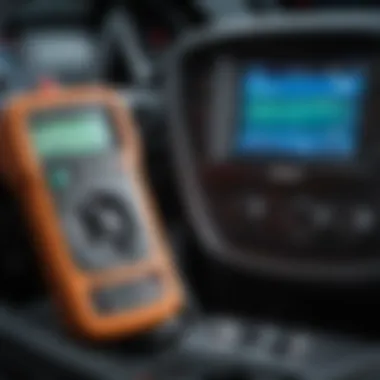Troubleshooting Daewoo Nexia Heating System Issues


Intro
Understanding the heating system issues in the Daewoo Nexia is essential for both enthusiasts and car owners. The heating system is critical for cabin comfort and vehicle performance in colder climates. Insufficient airflow from the heating unit is a common problem, which can lead to an uncomfortable driving experience. This article will navigate through various aspects related to the heating system, focusing on the roots of the airflow issues, diagnostics, and practical solutions to mitigate these problems.
Обзор автомобиля
The Daewoo Nexia is a compact car that has gained popularity in various markets.
Основные характеристики
This vehicle is recognized for its reliability and budget-friendly maintenance. Typically, it features a modestly sized body, making it ideal for city driving. The interior provides adequate space for passengers while maintaining simplicity in design. Such practical characteristics appeal to a wide range of users, from families to daily commuters.
Описание двигателей и трансмиссий
Under the hood, the Nexia commonly houses a 1.5-liter engine, though variations may exist depending on the market. It often comes with a manual transmission, offering drivers a sense of control over their driving experience. Automatic transmission options are available but may vary by model year. Driving enthusiasts value the narrow range of engine options for tuning and performance modifications.
If you are considering the heating system performance, the engine’s efficiency and its maintenance are crucial. A well-performing engine influences the heating unit's operation, directly affecting airflow.
Выбор автозапчастей
When trouble arises in the heating system, selecting the right auto parts is key to resolving any issues.
Разновидности запчастей
Parts related to the heating system include the heater core, blower motor, and various ducts. Each component plays a role in how well the heating system operates. Aftermarket parts are available, but distinguishing between quality can be challenging.
Как выбрать качественные запчасти
To ensure you select quality replacement parts:
- Research reputable suppliers and brands.
- Check reviews and ratings to gauge customer satisfaction.
- Ask for recommendations from experienced mechanics or fellow car enthusiasts.
"Selecting the right parts ensures the longevity and performance of your vehicle's heating system."
Taking these steps can save time and expenses in the long run, making your overall experience with the Daewoo Nexia much more enjoyable.
Overview of Daewoo Nexia Heating System
Understanding the heating system in the Daewoo Nexia is essential for both car owners and mechanics. This vehicle, like many others, relies heavily on a proficient heating system to provide comfort and ensure efficient operation. The heating system affects not only passenger comfort but also defrosting capabilities crucial for driving safety in colder conditions. A lack of efficiency in this system can lead to multiple failures, making it vital to recognize its importance.
Importance of Efficient Heating
Efficient heating serves several key purposes. Firstly, it ensures that passengers remain comfortable in various weather conditions. This is not merely a luxury; rather, it significantly impacts the driver's ability to operate the vehicle safely. If visibility is impaired due to fogged windows, which cold temperatures can cause, it increases the likelihood of accidents. Secondly, an effective heating system supports engine performance. When the heating system is not functioning properly, it may affect engine temperature regulation, possibly causing overheating or inefficient fuel consumption.
All these factors make it clear that the efficiency of the heating system can influence not only passenger comfort but also the overall condition and longevity of the vehicle.
Components of the Heating System
The heating system of the Daewoo Nexia consists of several interdependent components, each playing a crucial role in the process of heating the cabin. Understanding these components is fundamental for diagnosing issues that may arise. The main elements include:
- Heater Core: This small radiator-like device, situated in the dashboard, plays a central role in heating the air that enters the cabin. Hot engine coolant flows through it, warming up the air blown by the blower motor.
- Blower Motor: This fan pulls air from inside the vehicle or outside and pushes it through the heater core for distribution. A malfunctioning blower motor can result in poor airflow.
- Thermostat: A critical component that regulates engine temperature, helping to determine when to allow coolant flow through the heater core. A faulty thermostat can disrupt heating performance.
- Cabin Air Filter: This filter ensures that clean air enters the cabin by trapping dust and debris. A clogged filter can reduce airflow and hinder heating efficiency.
These components must work harmoniously for the heating system to function effectively, underlining the importance of regular maintenance and timely inspections. If any of these parts fail or become obstructed, the overall heating performance may diminish, leading to discomfort and potential safety risks.
Common Issues Faced
The heating system in the Daewoo Nexia is an essential component for passenger comfort, particularly in colder climates. Understanding common issues is crucial, as these problems can impact not only comfort but also the overall performance of the vehicle. Addressing heating system deficiencies early can prevent more extensive damage and costly repairs.


Poor Airflow Problems
Poor airflow from the heating system is a frequent complaint among Daewoo Nexia owners. This issue can stem from several factors, which may include a clogged cabin air filter, damaged ducts, or problems within the blower motor itself. When airflow is restricted, passengers may experience inadequate heat distribution throughout the cabin.
A major consequence of poor airflow is the frustration it causes for drivers and passengers. When the heating system fails to provide sufficient warmth, it leads to an uncomfortable ride, especially during winter travel. Not only does this decrease the riding experience, but it can also be hazardous as it might force drivers to focus more on adjusting their environment rather than driving.
It is important to diagnose airflow issues promptly. Early detection can lead to straightforward solutions, such as filter replacement or system cleaning, which can prevent more severe complications, like a complete blower motor failure. Therefore, regular checks on the heating system's performance are essential for maintaining effective airflow.
Insufficient Cabin Heating
Insufficient cabin heating is another prominent issue that Daewoo Nexia owners may face. This problem often occurs when the heater core fails to adequately transfer warmth into the cabin. Common causes include low coolant levels, a faulty thermostat, or blockages in the heater core itself.
The symptoms of insufficient heating typically present themselves as the vehicle's cabin remaining cold, even when the heating system is at full operation. This can lead to discomfort on the road. In severe cases, it may even compromise the functionality of other systems in the car, particularly if the engine is running cooler than optimal due to poor thermostat performance.
Addressing this issue involves a straightforward assessment of coolant levels and the condition of the thermostat. If these components are functioning correctly, further investigation into the heater core is warranted. Prompt restoration of proper cabin heating is vital, as it not only sets the mood in the vehicle but also ensures drivers can fully concentrate on their driving without distraction from discomfort.
"Addressing the basic issues of heating can greatly improve both comfort and safety during travels."
In summary, poor airflow and insufficient heating in the Daewoo Nexia are common but solvable problems. Automotive enthusiasts and drivers alike should remain diligent in monitoring their vehicles to tackle these concerns efficiently.
Understanding Airflow Issues
Airflow issues in the heating system of the Daewoo Nexia can significantly affect driving comfort. Effective airflow ensures that passengers experience consistent cabin temperatures. When the airflow is weak or nonexistent, it can lead to unsatisfactory conditions that compromise visibility and the overall driving experience. Timely identification of these issues is crucial to prevent further mechanical complications.
By comprehending airflow issues, car owners can engage more effectively with their vehicle's maintenance. Understanding how air moves through the system also aids in pinpointing precise problems, which can save time and resources.
Diagnosis of Airflow Deficiency
Diagnosing airflow deficiency involves several steps. First, one should observe any unusual noises from the heating system. For example, if you hear a low whistling sound, it may indicate a blockage or leak in the air ducts. Also, checking the blower motor is essential. If it does not operate correctly, it can fail to push air through the system.
Next, one should examine the cabin air filter. A clogged filter restricts airflow and can lead to discomfort. Typical symptoms are reduced air speed from the vents and, in some cases, fogging windows. Replacing a clogged filter often restores the vehicle’s heating efficiency quickly.
Additionally, inspect the heating pipes for kinks or obstructions. Ensure that no dirt or debris is blocking ventilation grilles, as this can hinder airflow.
Signs of Insufficient Air Output
Recognizing signs of insufficient air output is vital for maintaining a functioning heating system. Here are some common indicators:
- Weak air blowing from vents: This can signal a problem with the blower motor or ducts.
- Temperature inconsistencies: When one side of the cabin is warmer than the other, there might be a failure in the heating core or related components.
- Unusual odors: Any strange smells during heating could be a warning of failing components or built-up dirt within the system.
- Frequent system cycling: If the heater frequently turns on and off, it suggests electrical or mechanical irregularities.
"Recognizing airflow issues early can save both time and repair costs in the long run."
Understanding these signs aids in proactive maintenance. Proper knowledge empowers technicians and car owners to address issues before they escalate.
Causes of Poor Heating Performance
In understanding the performance of the heating system in the Daewoo Nexia, recognizing the causes behind poor heating is critical. Efficient heating is not just a matter of comfort; it influences the overall functionality of the vehicle and the driving experience. If issues arise, they can manifest quickly, leading to discomfort in cold weather or potential long-term damage to the system. Addressing these factors becomes essential for ensuring optimal vehicle performance.
Clogged Cabin Air Filter
A common culprit of inadequate heating performance is a clogged cabin air filter. This filter plays a vital role by trapping dust, pollen, and other contaminants entering the cabin. When it gets clogged, the airflow into the heating system is severely restricted. As a result, it prevents warm air from reaching the cabin effectively.
Signs of a clogged filter include:
- Decreased airflow from vents
- Unpleasant odors when the heater is on
- Whistling noise while the heater is operating
Replacing the cabin air filter is straightforward. It generally takes a few minutes and can significantly improve airflow. This simple intervention can restore heating efficiency without involving complex repairs.
Malfunctioning Heater Core


The heater core functions as a mini radiator within the vehicle's heating system. It uses hot coolant from the engine to provide heat to the cabin. If it malfunctions—due to corrosion, blockages, or leaks—its ability to transfer heat diminishes markedly. Consequently, the cabin may not heat up, even with the heater working at full capacity.
Symptoms of a malfunctioning heater core include:
- Cool air blowing from the vents
- Foggy windows due to moisture from coolant leaks
- A sweet smell inside the cabin, indicating coolant leakage
Repairing or replacing a heater core can be complicated and may require professional assistance. Regular inspection can help catch problems early, mitigating potential extensive repairs.
Thermostat Issues
The thermostat is critical for regulating the engine's temperature and plays a key role in the heating system. If it fails to open or close properly, coolant flow might be mismanaged, leading to fluctuations in heating performance. A stuck thermostat can either prevent the engine from reaching operating temperature or allow excess coolant, resulting in insufficient heating.
Signs of thermostat issues include:
- Temperature gauge fluctuating or not reaching normal levels
- Inconsistent cabin temperature
- Engine overheating or running cooler than normal
Addressing thermostat malfunctions often involves testing and replacement. Understanding its importance can help in scheduling timely maintenance.
Understanding the causes of heating performance issues is key to effective troubleshooting and repair. By addressing these common problems, owners can significantly enhance their vehicle's comfort and longevity.
Step-by-Step Troubleshooting
Troubleshooting the heating system in a Daewoo Nexia requires a systematic approach. This section outlines detailed steps that can help identify and resolve common issues effectively. A structured troubleshooting process is essential to prevent unnecessary repairs and to save time and resources. Identifying if the heating system issues stem from airflow problems, component failures, or sensor malfunctions is critical. Each step in the process builds on the previous one, ensuring comprehensive examination of each aspect of the heating system.
Initial Observation
The first part of troubleshooting involves paying careful attention to heaters' behavior and performance. This initial observation is crucial because it sets the stage for identifying specific issues. Look for signs such as uneven heating within the cabin, strange noises, or unusual smells. These can indicate whether there are underlying problems that require further investigation. It is best to note the temperature settings on the control panel and the actual temperature inside the vehicle. Taking notes will help when discussing issues with a mechanic or when proceeding to further steps in the troubleshooting process.
Physical Inspection of Components
After completing your initial observations, it's time to conduct a physical inspection of the heating system components. Begin by checking the cabin air filter. A clogged or dirty filter can significantly impact airflow. For the Daewoo Nexia, it is advisable to make sure that air ducts are free from obstructions. Next, examine the heater core for leaks or corrosion. The heater core can become a point of failure in the heating system if not inspected regularly. Ensure all hoses are connected tightly and show no signs of damage. Observing component condition while also being aware of the general layout of the heating system ensures no part is overlooked.
Testing Mechanisms and Sensors
With observations and physical checks complete, testing mechanisms and sensors in the heating system becomes necessary. Ensure that the thermostat is functioning correctly. If the thermostat is stuck open, it can prevent the system from warming up adequately. Additionally, explore the blower motor and ensure it operates at various speeds. Unusual sounds can indicate wear or malfunction. If the heating system is controll by electronic sensors, testing their functionality will clarify if they are providing accurate readings. Observing how these mechanisms work can reveal issues that were not apparent during the visual inspections or initial observations.
"Attention to detail during troubleshooting can save time and prevent costly repairs in the future."
By following these steps, car owners and enthusiasts can effectively diagnose issues within the heating system of the Daewoo Nexia. Establishing a methodical approach allows for identifying problems without second-guessing, leading to more straightforward solutions.
Solutions to Improve Heating Efficiency
The effectiveness of a vehicle's heating system is vital for both comfort and functionality. Improving heating efficiency in the Daewoo Nexia can have a significant impact, especially in colder climates. Addressing the common issues not only enhances the driving experience but also can prevent further costly repairs down the line. In this section, we will look at practical steps to increase the heating performance of the system, focusing on specific components and their treatment.
Replacing the Cabin Air Filter
The cabin air filter plays an essential role in maintaining air quality and ensuring proper airflow through the heating system. When this filter becomes clogged with debris, leaves, or contaminants, airflow is restricted. This can lead to inadequate heating within the cabin.
Steps to Replace the Cabin Air Filter:
- Locate the filter compartment, usually found behind the glove box.
- Remove any panels obstructing access to the filter.
- Carefully remove the old filter.
- Install a new filter, ensuring it aligns correctly with airflow directions.
- Reassemble any components you took apart.
By routinely replacing the cabin air filter every 12,000 to 15,000 miles, drivers can enhance the heating system's performance while also maintaining better air quality inside the car.
Repairing or Replacing Heater Core
The heater core is a critical component responsible for transferring heat from the engine coolant to the cabin air. If the heater core is malfunctioning, it can cause insufficient heating and may even lead to leaks within the system.


- Signs of a Failing Heater Core:
- Sweet smell of coolant inside the cabin.
- Wet carpet or moisture around the footwells.
- Low cabin temperature despite the heater being on.
Steps to Repair or Replace the Heater Core:
- Safely drain the coolant from the system.
- Disconnect hoses attached to the heater core.
- Remove the dashboard if needed, depending on access.
- Unscrew the heater core from its housing.
- Replace with a new heater core and reassemble.
This task requires some mechanical skill but can lead to a significant improvement in heating efficiency if done correctly.
Thermostat Replacement Procedure
The thermostat regulates the engine's temperature by controlling the flow of coolant. If it becomes stuck in the open position, the engine may run too cool, leading to ineffective heating. Conversely, if it stays closed, overheating can occur, damaging engine parts.
Signs of a Thermostat Issue:
- Fluctuating engine temperature readings.
- No heat during idling.
- Overheating engine warning lights.
Thermostat Replacement Steps:
- Allow the engine to cool down completely.
- Drain a portion of the coolant.
- Locate the thermostat housing and remove it.
- Take out the faulty thermostat.
- Install the new thermostat and reattach the housing.
Regular testing and replacement of the thermostat ensure optimal heating system performance and overall engine efficiency.
Regular Maintenance Practices
Regular maintenance practices are essential to ensure the heating system in the Daewoo Nexia operates efficiently. Maintaining the heating system means addressing not just repairs but also preventive measures that can avert issues before they arise. Efficient heating contributes significantly to a comfortable driving experience, particularly in extreme weather, and neglecting maintenance can lead to long-term damage.
Importance of Seasonal Checks
Conducting seasonal checks of the heating system is crucial. These regular observations allow vehicle owners to identify minor issues before they escalate. Inspecting components such as the heater core and thermostat can pinpoint signs of wear. Additionally, ensuring that coolant levels are adequate helps prevent overheating, which can damage the engine or the heating system itself.
- Key Benefits:
- Early identification of potential issues
- Extended lifespan of heating components
- Enhanced comfort during winter driving
Seasonal checks should not be overlooked. These practices imbue vehicle owners with knowledge about their vehicle’s condition, resulting in better decision-making regarding repairs and maintenance. Regular checks provide peace of mind.
Routine Filter Changes
Routine filter changes are vital for maintaining air quality within the vehicle cabin. A clogged cabin air filter restricts airflow, creating discomfort for passengers and potentially leading to overheating of the heating system. Sale of cabin air filters should be coordinated with the vehicle’s annual service or routine maintenance schedule.
- Considerations for Filter Changes:
- Check every 12,000 to 15,000 miles
- Choose high-quality filters for effective results
- Inspect the filter during seasonal checks as well
By adhering to a schedule for filter changes, drivers can ensure that the heating system functions without unnecessary strain. This small maintenance step can lead to significant improvements in overall vehicle performance.
"Routine maintenance can save vehicle owners from expensive repairs in the future."
To conclude, regular maintenance practices focus on improving the heating system's efficiency in Daewoo Nexia. Seasonal checks and timely filter changes enhance airflow while preventing larger issues from developing. This approach ensures that both drivers and passengers enjoy optimal comfort throughout the year.
Finale on Heating System Issues
The discussion surrounding heating system issues in the Daewoo Nexia reveals critical insights into the car's functionality and user experience. Many vehicle owners rely heavily on their heating systems, especially in colder climates. Therefore, understanding these issues becomes essential not only for maintaining comfort but also for ensuring overall vehicle safety and performance. This section synthesizes vital elements that have been covered, highlighting their significance and benefits.
Summary of Key Points
- Efficiency is Crucial: An efficiently functioning heating system enhances the driving experience, ensuring that the interior climate is comfortable. Poor performance can lead to dissatisfaction and potential safety hazards.
- Common Problems Identified: Issues such as poor airflow and insufficient cabin heating were explored. Recognizing these issues early can lead to timely repairs, preventing more extensive damage and costly fixes later on.
- Maintenance Necessity: Regular maintenance practices play a pivotal role in keeping the heating system operational. Seasonal checks and routine filter changes are fundamental steps that should not be overlooked.
- Diagnostic Approaches: Effective troubleshooting steps were discussed, including inspection methods and testing protocols. Equipping car owners and mechanics with the knowledge to identify problems can lead to more effective resolutions.
- Solutions Offered: Concrete solutions for common issues have been provided. These include replacing air filters, repairing or changing heater cores, and managing thermostat functions.
Final Recommendations
- Prioritize Regular Maintenance: Vehicle owners should commit to a routine maintenance schedule to safeguard against heating system failures. Setting reminders for seasonal checks can be beneficial.
- Educate Yourself on Troubleshooting: Understanding the basics of airflow and cabin heating issues enables better communication with mechanics and DIY repairs. Awareness of symptoms can lead to faster resolutions.
- Use Quality Replacement Parts: When it comes to repairs, using original or high-quality replacement parts is crucial for long-term functionality. Inferior parts can lead to further issues down the line.
- Seek Professional Help if Needed: While some issues may be manageable for hobbyists, complex problems often require expert intervention. Do not hesitate to consult mechanics when necessary to avoid potentially dangerous situations.
- Stay Informed: Keeping up with recalls and updates concerning the Daewoo Nexia can provide essential information for avoiding issues and ensuring safety.
"Investing time in understanding your vehicle's heating system can lead to better performance and a safer, more comfortable driving experience."







